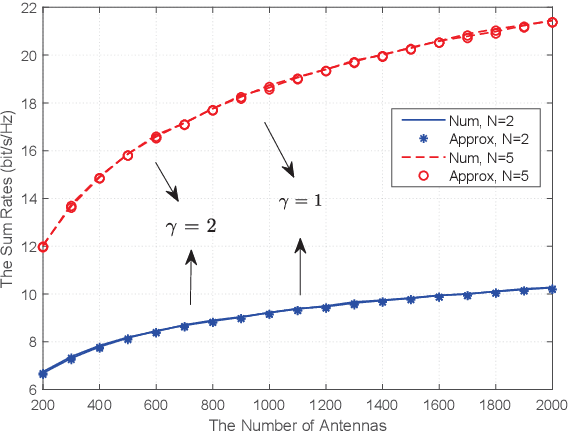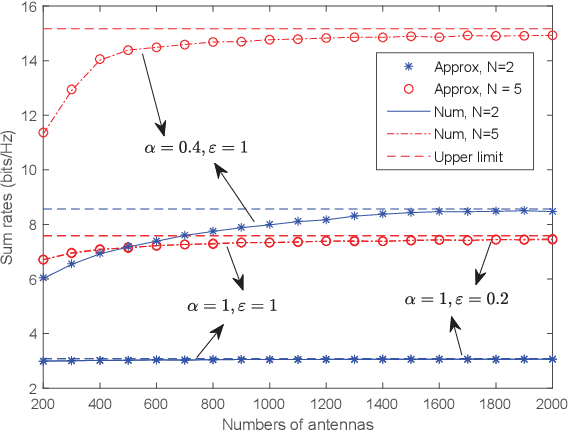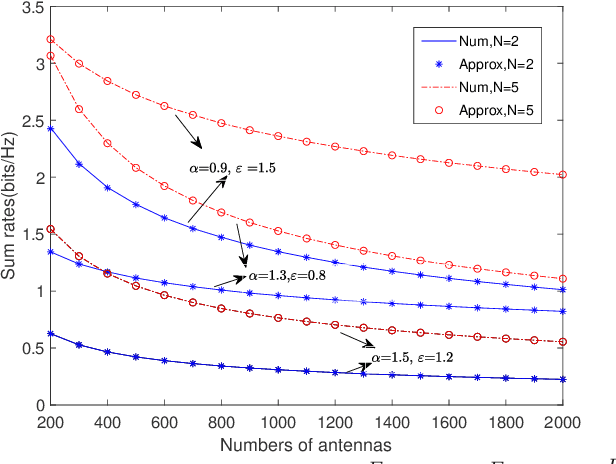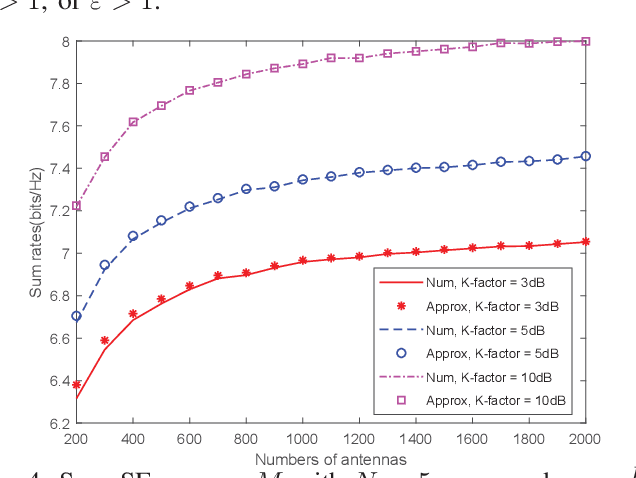Xianzhe Chen
Near-Field XL-MIMO Systems with Sparse UPAs
Jan 16, 2025Abstract:This paper investigates a downlink near-field extremely large-scale multiple-input multiple-output (XL-MIMO) communication system with sparse uniform planar arrays (UPAs). Based on the Green's function-based channel model, the paper focuses on the power distribution of the arrived signal near the focused point of the transmit sparse UPA. In the vicinity of the focused point, along the x-axis and z-axis directions, closed-form expressions for the power distributions are derived. Based on that, expressions for the width and length of the main lobe are obtained in closed form, both of which decrease as the antenna spacing increases. Furthermore, the paper introduces a crucial constraint on system parameters, under which effective degrees-of-freedom (EDoF) of XL-MIMO systems with sparse UPAs can be precisely estimated. Then, the paper proposes an algorithm to obtain a closed-form expression, which can estimate EDoF with high accuracy and low computational complexity. The numerical results verifies the correctness of the main results of this paper. Furthermore, the numerical results reveals the improvement in the performance of XL-MIMO systems with the use of sparse UPAs.
Effective DoF-Oriented Optimal Antenna Spacing in Near-Field XL-MIMO Systems
Jan 13, 2025Abstract:This letter investigates the optimal antenna spacing for a near-field XL-MIMO communication system from the perspective of the array gain. Specifically, using the Green's function-based channel model, the letter analyzes the channel capacity, which is related to the effective degrees-of-freedom (EDoF). Then, the letter further investigates the applicability of two EDoF estimation methods. To increase EDoF, this letter focuses on analyzing the impact of antenna spacing. Furthermore, from the perspective of the array gain, the letter derives an approximate closed-form expression of the optimal antenna spacing, at which EDoF is maximized and the array gain at the antenna nearest to the focused antenna of the transmit array becomes zero. Finally, numerical results verify the main results of this letter.
Performance Analysis on RIS-Aided Wideband Massive MIMO OFDM Systems with Low-Resolution ADCs
Mar 14, 2024Abstract:This paper investigates a reconfigurable intelligent surface (RIS)-aided wideband massive multiple-input multiple-output (MIMO) orthogonal frequency division multiplexing (OFDM) system with low-resolution analog-to-digital converters (ADCs). Frequency-selective Rician fading channels are considered, and the OFDM data transmission process is presented in time domain. This paper derives the closed-form approximate expression of the uplink achievable rate, based on which the asymptotic system performance is analyzed when the number of the antennas at the base station and the number of reflecting elements at the RIS grow to infinity. Besides, the power scaling laws of the considered system are revealed to provide energy-saving insights. Furthermore, this paper proposes a gradient ascent-based algorithm to design the phase shifts of the RIS for maximizing the minimum user rate. Finally, numerical results are presented to verify the correctness of analytical conclusions and draw insights.
Performance Analysis and Optimization for RIS-Assisted Multi-User Massive MIMO Systems with Imperfect Hardware
Aug 17, 2022



Abstract:The paper studies a reconfigurable intelligent surface (RIS)-assisted multi-user uplink massive multiple-input multiple-output (MIMO) system with imperfect hardware. At the RIS, the paper considers phase noise, while at the base station, the paper takes into consideration the radio frequency impairments and low-resolution analog-to-digital converters. The paper derives approximate expressions for the ergodic achievable rate in closed forms under Rician fading channels. For the cases of infinite numbers of antennas and infinite numbers of reflecting elements, asymptotic data rates are derived to provide new design insights. The derived power scaling laws indicate that while guaranteeing a required system performance, the transmit power of the users can be scaled down at most by the factor 1/M when M goes infinite, or by the factor 1/(MN) when M and N go infinite, where M is the number of antennas and N is the number of the reflecting units. Furthermore, an optimization algorithm is proposed based on the genetic algorithm to solve the phase shift optimization problem with the aim of maximizing the sum rate of the system. Additionally, the optimization problem with discrete phase shifts is considered. Finally, numerical results are provided to validate the correctness of the analytical results.
Multi-Pair Two-Way Massive MIMO DF Relaying Over Rician Fading Channels Under Imperfect CSI
Oct 28, 2021



Abstract:We investigate a multi-pair two-way decode-andforward relaying aided massive multiple-input multiple-output antenna system under Rician fading channels, in which multiple pairs of users exchange information through a relay station having multiple antennas. Imperfect channel state information is considered in the context of maximum-ratio processing. Closedform expressions are derived for approximating the sum spectral efficiency (SE) of the system. Moreover, we obtain the powerscaling laws at the users and the relay station to satisfy a certain SE requirement in three typical scenarios. Finally, simulations validate the accuracy of the derived results.
 Add to Chrome
Add to Chrome Add to Firefox
Add to Firefox Add to Edge
Add to Edge